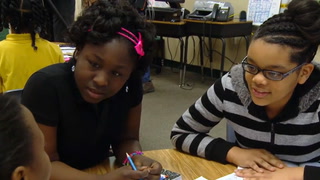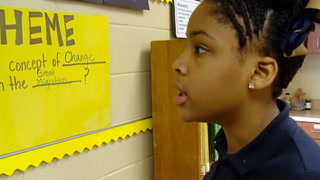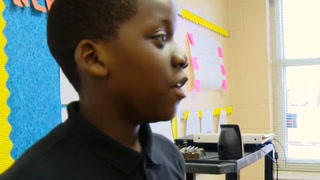The Great Migration: Analyzing Point of View Transcript
[00:00:00;00] - [00:14:13;03]
Student: Everyone, what is our universal theme for today?
Students: Change.
Sherwanda Chism: I am Dr. Sherwanda Chism and I teach 4th and 5th grade gifted students in an urban population. Today's lesson on the Great Migration is a part of a unit on the Harlem Renaissance. Before students can delve into the advancement, the contributions in the areas of literature, art and music, they first have to know why there was a surge of African Americans in the Great City of Harlem. So, today's lesson, students are analyzing the viewpoints of all the stakeholders that were involved in the Great Migration.
Student: Our agenda for today is Brainstorming, Group Discussion and Reasoning About Situation.
Sherwanda Chism: The day began with Cornelius walking us through what was going to happen. After that, we're using our brainstorming strategy to come up with stakeholders and students analyze from the point of view of a stakeholder. The students post up their work using graphic organizers and they critique each other's work so that they can hear if they need to make changes.
[00:01:20;15]
Sherwanda Chism (in class): So, we've read several texts. Our nonfiction books have given an account of the Great Migration are here and we've read the texts that you have in front of you. What I want you to do right now in your composition book - I want you to use the knowledge that you've gained from these different texts to list stakeholders. Stakeholders from the Great Migration in your composition books, okay? I want you to talk to your...
Sherwanda Chism: I saw that look. They gave me that look. There was that little silence. I assumed that students knew what "stakeholders" meant. And I knew then that I needed to reiterate to my students what a stakeholder was.
Sherwanda Chism (in class): Before we begin, I want everybody to stop and look at me. Everybody lookin' at me? Red dot's on my forehead? Everybody's looking? I want you to talk in your groups quickly and tell the other people in the group what a stakeholder is. Quickly so that I know I'm not dreaming.
Student: Somebody that have a place in the Bib___ or the situation.
Sherwanda Chism: I wanted them to know that a stakeholder is not always someone who gains. A person that stands to lose can also be considered a stakeholder. And so from then, I knew that they understood what stakeholders were.
Sherwanda Chism (in class): What I want you to do now, I want you to list the stakeholders on your own of the Great Migration. All right, let's go.
[00:02:41;26]
Sherwanda Chism (in class): I like the way you guys are looking back through the different texts. And I want you to be specific. Let's look up. I want you to talk to the people in your group. And talk about the stakeholders that you've listed in your composition. So I'm listening for accountable talk as well.
Sherwanda Chism: On the children’s' tables, there is a cardstock with stems and I call them accountable talk stems. Students know that when they speak, they ought to use an accountable talk stem.
Student: I agree and both disagree with Kaya.
Sherwanda Chism: You notice, they didn't necessarily pick these up because we've been using this --- it's become a normal practice.
Student: I'd like to add on to this conversation and say, I have the agriculture workers because one, they were thrown off their land that they have worked on so I say they were part of this because maybe they have migrated to a different country.
Sherwanda Chism (in class): Okay, so now I want you to be prepared to list some stakeholders on the paper and remember, I'm gonna bail out and let you guys take over.
Student: The people that already have a job in the North.
[00:03:56;03]
Student: The providers of the jobs.
Sherwanda Chism: After we talked about the stakeholders, we talked about the benefits and the challenges of this migration.
Sherwanda Chism (in class): What were some of the benefits? Rachel?
Student: There were more economic upgrades.
Sherwanda Chism (in class): I like that. Economic upgrades. Okay, can you specific and give me an example of an economic upgrade?
Student: Well, in the South, they were not getting paid as much. In the North, you know, all they had to do was just tell them, we're giving you a little bit more. Back then, that was a lot to them.
Sherwanda Chism (in class): What were some of the challenges? Oh, I see hands. I see hands.
Student: They didn't know what to do when they got to the North and, like, for instance, they didn't know how to build a building.
Sherwanda Chism (in class): Ok. Can you tell me where you'd find that information? I want you to locate that in one of the texts that we've read.
Sherwanda Chism: I think with common core, everybody can participate. Because you're leveling the playing field. Children don't have to come with prior knowledge. We give them a foundation of knowledge through the reading of text.
Sherwanda Chism (in class): What I want to do now, I want you to pull out the text, The Great Migration. We've read a lot of texts because we're building our knowledge. We're building our knowledge through reading text. I'm gonna give you a few moments to skim through the text.
[00:05:24;29]
Sherwanda Chism: Since I was teaching reason about a situation based on point of view, there was a very one-sided text that was from that website. I chose to use that text.
Sherwanda Chism (in class): If you only had this text, if this was the only text that we had to read, would you say that this would give us a good idea of what went on --- what happened?
Students: Yes.
Sherwanda Chism (in class): Okay, so, you think...
St; It wouldn't be such a good text because you only have the perspective of one side of the story.
Sherwanda Chism (in class): You only have the perspective of --- you stealin my thunder! You're only hearing the perspective of one side of the story so what we'd say is the speaker's point of view is limited. And do you know what I mean by limited?
Student: You only have a certain amount.
Sherwanda Chism (in class): You only have a certain amount.
Student: Let's say you're doing a paragraph and your teacher says your information is limited, that means that you don't have enough and you have to put more sentences, more information so the reader can understand.
Sherwanda Chism (in class): Okay, so let's go back to the question: is this speaker's point of view limited?
Student: He has so many things about the South that he didn't like. He mostly --- he didn't really give any pull factors that would make you go back to the South.
Student: I have a question. Why do you think that he would be --- a migrant? Because, you know in the text, it's really talking about the South, so, I mean in the North they're just not talking about that much so why do you think that he's a migrant?
[00:06:55;10]
Student: I would think he's a migrant because moving from --- if he had moved from the South, he can let you know what's gonna happen in the South if you wanted to move to the South.
Student: But he moved to the North. Why didn't he give me any information for the North?
Sherwanda Chism: With common core, one of the things that we've found is that those students who are doing the talking --- the ones that are doing the most learning, and they learn from their peers. They piggy-back and they increase their knowledge by participating in group discussions.
Sherwanda Chism (in class): You have to know the point of view, or you have to know more than one side in order to really see a good picture of something, right? Okay? So, what we're gonna do now, we're gonna analyze the situation. The situation is the Great Migration. But we're gonna analyze it from the point of view of different stakeholders, okay?
Sherwanda Chism: Looking at The Great Migration, I wanted the students to be able to look at it through different lenses and so each group had to analyze from the eyes of different stakeholders.
Sherwanda Chism (in class): When you analyze your stakeholder, you're going to use the graphic organizer, ok? You see the graphic organizer when we've had maybe four or five stakeholders, but today we're gonna just analyze one stakeholder.
Sherwanda Chism: They love the graphic organizer. It always frames their discussion. I know at this point, I'm going to speak on stakeholders. At this point in the graphic organizer, I'm going to record information as far as their point of view. So, graphic organizers, they help us to organize our thoughts, they can be tools for conversation.
Student: What is the situation?
Sherwanda Chism: They analyze. They ask questions.
Student: The farmers or the landowners?
Sherwanda Chism: I also put little questions on the graphic organizer because I want them to be sure that they know what the words, "point of view" mean. What the words "assumptions" mean.
[00:08:39;01]
Sherwanda Chism (in class): Up front, you see examples of assumptions and you see examples of implications. So, use these. Use the walls. Use your graphic organizer to help you, okay?
Sherwanda Chism: After students recorder their data on their graphic organizers, they posted it in the room.
Sherwanda Chism (in class): Now, let's come back to our seats, when we're done go back to your seats, get some sticky notes, getting ready for our gallery walk. Mia says, "I love gallery walk because I get to criticize." We're not criticizing, Mia, we're critiquing. We're gonna frame our critiques with --- "I notice" and "I..."
Students: Wondered.
Sherwanda Chism: We use stems, "I noticed" and "I wondered" to frame our critiques. The purpose of critiques is not to say, "oh, that's wrong," it's really to get you thinking about what you've done so that you can really self-correct. What students did, is they walked around and they read everybody's graphic organizer and they critiqued them by putting a sticky note on them saying what they noticed.
Sherwanda Chism (in class): I want you at this time to look at the critiques --- look at the critiques of your peers and if you see fit, you can make changes to make it better. Take it back to your tables and let's do that now.
St; Someone put, "why do we start all our sentences with "they."
Student: And I agree because we wasn't very specific with like --- it could have been anybody. We wasn't that specific with who "they" were. We're changing "they" to "the migrants."
Sherwanda Chism: I give them the opportunity to read the critiques of their peers so that they can make changes and sometimes they can be a little tough but it's coming from their peers so it takes it off of the teacher and I think we learn best from our peers.
Sherwanda Chism (in class): Let's think about what we've done. Let's think about our graphic organizers. Did everybody make changes?
Students: Yes.
Sherwanda Chism (in class): Okay, everybody made changes. Can you give me an example of a change that you made after the critique?
Student: They said, "I noticed you did not include the boll weevil eating the crops." And we were going on a debate about, "should we include it or not?" And I said, we should because the pull factor was there already signed to leave because of the better wages, better education and they could get a house.
[00:11:05;03]
Sherwanda Chism (in class): And your point, Cornelius?
Student: My point was that we should include it because it's the main thing that is insuring the main cash crop is cotton.
Sherwanda Chism: Cornelius, he gave evidence as to why he felt that way and she did the same thing. And she gave evidence so in my opinion, they're both right. It all goes back to teaching children how to agree and to disagree and to do it respectfully.
Student: I'd like to participate in the conversation and say there was no way for them to make money so they will move up to the North because of the boll weevil. It was a reason that they had the Great Migration --- because of the boll weevil.
Student: They were probably only making a penny a day so they wouldn't care because they weren't making money, anyway.
Student: I'd rather have a penny than have nothing at all.
Sherwanda Chism: In the real world, we don't all agree and our thoughts are shaped by our points of views. They had an amazing debate and it was a respectful one.
Sherwanda Chism (in class): I want you to think about this activity and the purpose of it. Now, I didn't tell you the purpose of it but I want you to tell me, "why did we identify the stakeholders?" Yes, ma'am?
Student: Well, now we understand the situation more in who is really involved and what we need to really focus on during this unit of study.
Sherwanda Chism (in class): Remember, we're studying the Harlem Renaissance. But before we can study the Harlem Renaissance, we've got to know from where these artists, these dancers, these musicians --- where their influence is from and why do they end up in Harlem? That's why we're studying the Great Migration.
Sherwanda Chism: To table the lesson, we used Gems and Opportunities. And what Gems and Opportunities does, it just gives them the opportunity to say what they gained from the lesson. I know what I want the goal of the lesson to be but they tell me what they learned.
Sherwanda Chism (in class): Remember, a gem is something valuable and an opportunity is something that we can improve on.
Student: A gem for me, today was debating with Kira because it was very fun and it really helped me think about how we should include it or not include it.
Sherwanda Chism (in class): Okay, opportunities, yes?
Student: We should actually use more evidence because we have a lot of -- you should use more proof and we should start to give more evidence.
Sherwanda Chism (in class): Okay, so we're going to get ready to table this lesson for today but we know that any time you reason about a situation regardless of what the situation --- in your everyday lives, you have to consider the different points of views of the situation.
Sherwanda Chism: Even though we were analyzing the point of view of stakeholders, they also got to see the point of view of their peers. I think it's so much more than just the lesson itself, is teaching them those life skills so they'll be prepared to talk, to discuss, to argue, to debate. That's what this lesson provided.
[00:14:13;03]
END














26 Comments
Couri Johnson May 26, 2022 7:48pm
She provided great scaffolding in the beginning by holding class discussion about the lesson material before moving into the individual group work, taking time to notice when things were or were not comprehended, and providing an explanation when not. The use of the sticky notes in peer-critique and the talking stems allowed for the students to provide feedback in a way that was more objective by removing any potential inter-personal relationship weights that might affect the kind of feedback being given or received. Peer-critique is effective in general in allowing the students to present themselves as experts, and the sticky notes in particular and the "gallery" style or review will allow students who maybe lack that confidence to check how other students are forming their feedback, giving them a model to develop their own skills at thinking critically about others work.
Marianna Mushailov Jan 23, 2021 12:56am
Great example of Culturally Responsive Teaching! The teacher joins students as a partner in the their learning process. Well done, Dr. Chism!
Mallory Brito Aug 13, 2018 8:35pm
It is apparent Mrs. Chrism has established an environment in her classroom where students feel safe to take risks, speak openly and freely, as well as think analytically about each other's points. This is evident when the two students began a sophisticated, respectful, and evidence-based debate in the middle of the class which enriched the overall learning in the classroom. I think the stems that are provided and clearly practiced help facilitate participation in a strategic, prepared and precise manner. It was evident the students were in control of the learning as they, not the teacher, were doing more of the talking in this lesson. As a result, students arrived at their own conclusions regarding point of view of stakeholders, rather than being told and guided. This is the definition of authentic learning.
Tiffany Lloyd Jun 21, 2018 2:18pm
Rebecca Taylor Feb 10, 2018 5:00pm